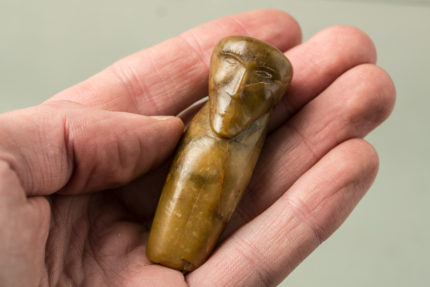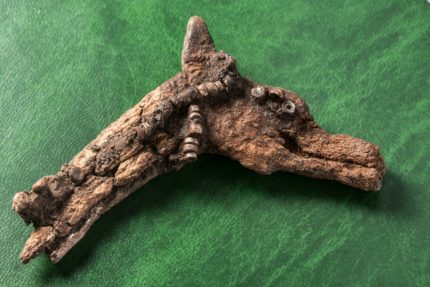Archaeologists excavating the Bronze Age burial ground of Itkol II in the Republic of Khakassia, southern Siberia, have unearthed two children’s toys from the Okunev culture. They’re the heads of figurines. One is a soapstone cylindrical piece about two inches long with finely carved facial features. The striking eyes and long eyelashes or brows may suggest a female face. The other is the head of an animal of undetermined type (horse? dragon? dog? seahorse?) carved out of horn or antler. No remains of the figurines’ bodies, likely made from an organic material or materials, have survived.
Each were discovered in a child’s grave. The burial itself was a simple commoner’s grave, so these were not elite grave goods. (The elite were buried in large, well-appointed tumuli, a distinctly fancier setting than these inhumations.) The lack of symbols, carvings or any other indications of a ritual or religious significance suggests the carvings weren’t talismans or charms to accompany the dead, but the beloved toys of an all too brief childhood.
The Okunev culture is seen as having links to Native Americans – and this is not the first time their toys have been found.
Indeed, the latest finds add to an intriguing collection. A figurine of a pagan god pulled out of a Siberian river by an angler was likely a child’s toy or rattle to ward off evil spirits. It has almond-shaped eyes, a large mouth with full lips, and a ferocious facial expression. On the back is ‘plaited hair with wave like lines. Below the plait there are lines looking like fish scales.’
Fisherman Nikolay Tarasov made ‘the catch of a lifetime’, said museum staff.
At the time of its discovery archaeologists were less definitive about which culture may have created the rattle or idol. The Okunev weren’t the only people in the area about 4,000 years ago. It also wasn’t certain that it actually was a toy, even though the press ran with the idea that it was a child’s rattle made to look fearsome. Many “oldest toy in the world looks like scary old fishgod!1” headlines ensued. At least these two pieces were found in undisturbed children’s graves in an extensively explored Okunev burial ground used by people of various social levels for centuries, so the speculation is a tad more grounded in archaeological context.

